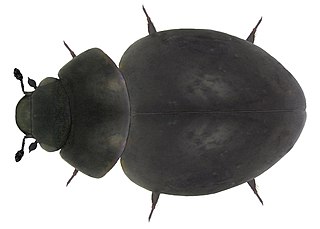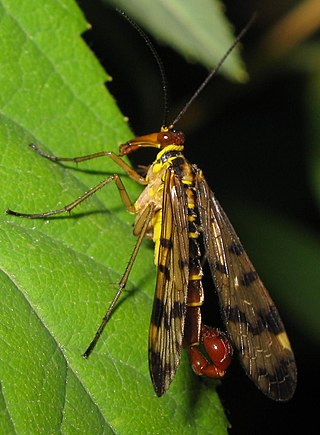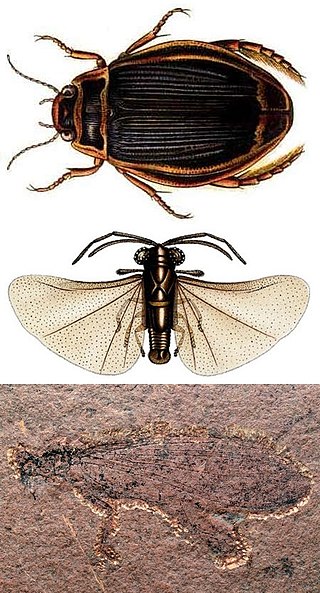
The sap beetles, also known as Nitidulidae, are a family of beetles.

Sphaerius is a genus of beetles in the family Sphaeriusidae, comprising 18 species. It is one of the two extant genera in the family, the other being Bezesporum. They are typically found along the edges of streams and rivers, where they feed on algae; they occur on all continents except Antarctica. Three species occur in the United States.

Holometabola, also known as Endopterygota, is a superorder of insects within the infraclass Neoptera that go through distinctive larval, pupal, and adult stages. They undergo a radical metamorphosis, with the larval and adult stages differing considerably in their structure and behaviour. This is called holometabolism, or complete metamorphism.

The Archostemata are the smallest suborder of beetles, consisting 45 living species in five families. They are an ancient lineage with a number of primitive characteristics. Antennae may be thread-shaped (filiform) or like a string of beads (moniliform). This suborder also contains the only beetles where both sexes are paedogenic, Micromalthus debilis. Modern archostematan beetles are considered rare, but were more diverse during the Mesozoic. The term "Archostemata" is used more broadly by some authors to include both modern archostematans as well as stem-group beetles like "protocoleopterans", which some modern archostematans closely resemble to due to their plesiomorphic morphology. Genetic research suggests that modern archostematans are a monophyletic group. Some genetic studies have recovered archostematans as the sister group of Myxophaga.

Myxophaga is the second-smallest suborder of the Coleoptera after Archostemata, consisting of roughly 65 species of small to minute beetles in four families. The members of this suborder are aquatic and semiaquatic, and feed on algae.

Lepicerus is a genus of myxophagan beetles containing three described species in the family Lepiceridae; it is the only extant genus in the family, with another genus, Lepiceratus only known from fossils. Extant species occur in the Neotropics, from Mexico south to Venezuela and Ecuador. Fossils referrable to the genus are known from the early Late Cretaceous of Southeast Asia.
This list of fossil arthropods described in 2013 is a list of new taxa of trilobites, fossil insects, crustaceans, arachnids and other fossil arthropods of every kind that have been described during the year 2013. The list only includes taxa at the level of genus or species.

The Protocoleoptera are a paraphyletic group of extinct beetles, containing the earliest and most primitive lineages of beetles. They represented the dominant group of beetles during the Permian, but were largely replaced by modern beetle groups during the following Triassic. Protocoleopterans typically possess prognathous (horizontal) heads, distinctive elytra with regular window punctures, culticles with tubercles or scales, as well as a primitive pattern of ventral sclerites, similar to the modern archostematan families Ommatidae and Cupedidae. They are thought to have been xylophagous and wood boring.
Tshekardocoleoidea is a superfamily in the extinct suborder Protocoleoptera that contains the following families:

Permocupedidae is a family of Protocoleopteran stem group beetles. They first appeared during the Early Permian, and were one of the dominant groups of beetles during the Middle Permian. They became rare in the Late Permian, with only one species known from the Triassic, Frankencupes ultimus from the Middle Triassic (Anisian) Röt Formation of Germany. They are thought to have been xylophagous, which is presumed to be the ancestral ecology of beetles.
2019 in paleoentomology is a list of new fossil insect taxa that were described during the year 2019, as well as other significant discoveries and events related to paleoentomology that were scheduled to occur during the year.
2017 in paleoentomology is a list of new fossil insect taxa that were described during the year 2017, as well as other significant discoveries and events related to paleoentomology that were scheduled to occur during the year.

Bromiini is a tribe of leaf beetles in the subfamily Eumolpinae. The tribe contains approximately 120 genera, which are found worldwide. They are generally thought to be an artificial group, often with a subcylindrical prothorax without lateral ridges and covered with setae or scales.
2015 in paleoentomology is a list of new fossil insect taxa that were described during the year 2016, as well as other significant discoveries and events related to paleoentomology that were scheduled to occur during the year.
2015 in paleoentomology is a list of new fossil insect taxa that were described during the year 2015, as well as other significant discoveries and events related to paleoentomology that were scheduled to occur during the year.

Tshekardocoleidae is an extinct family of beetles, known from the Permian. They represent amongst the oldest beetles. Like other primitive beetles, they are thought to have been xylophagous. They first appeared during the Cisuralian, before becoming extinct at the beginning of the Guadalupian. A claimed Jurassic record is doubtful. The oldest known beetle, Coleopsis, was originally assigned to this family, but is now assigned to its own family Coleopsidae.
This paleoentomology list records new fossil insect taxa that are to be described during the year 2022, as well as notes other significant paleoentomology discoveries and events which occurred during that year.

Coleopterida is a superorder of insects consisting of the orders Coleoptera and Strepsiptera. It is established as the sister group of Neuropterida based on phylogenetic analysis of DNA sequence data. The grouping is also supported by morphological data. The Coleopterida are estimated to have first appeared during the Carboniferous period, but the earliest confirmed fossils of the group date to the Permian. The Carboniferous insect species Stephanastus polinae has been interpreted by some authors as the sister group of Coleoptera and Strepsiptera, but this interpretation has been disputed and it has been alternatively suggested to be a member of the extinct order Protelytroptera.
This paleoentomology list records new fossil insect taxa that were described during the year 2014, as well as notes other significant paleoentomology discoveries and events which occurred during that year.
This list of 2023 in paleoentomology records new fossil insect taxa that are to be described during the year, as well as documents significant paleoentomology discoveries and events which occurred during that year.












